Anti-tank weapons of the Soviet infantry (part 2)
After the end of World War II, the Soviet infantry arsenal had 14,5-mm anti-tank rifles and RPG-43 and RPG-6 hand-held cumulative grenades, which no longer corresponded to modern realities. Anti-tank rifles, which showed themselves well in the initial period of the war, could not penetrate the armor of promising tanks even when shooting point-blank, and the use of hand-held anti-tank grenades was associated with a very high risk. The Soviet military leadership was well aware of the need to create light and effective anti-tank weapons that could fight not only existing, but also promising tanks. Although the development of rocket-propelled grenade launchers firing cumulative grenades began as early as the war years, they entered service after the war.
In 1942, in SKB №36 of the USSR People's Commissariat of the Petroleum Industry under the leadership of the chief designer N.G. Grigorian started designing an LNG-82 heavy-duty grenade launcher. Initially, the developers planned to use a “turbojet” grenade, the stabilization of which on the trajectory was carried out by rotation. However, tests have shown that when rotating at a speed of several hundred revolutions per second, a strong “splashing” of the cumulative jet occurs, which adversely affects the penetration resistance. In this regard, it was decided to re-construct the cumulative ammunition and execute it non-rotating. After that, the designer P.P. Shumilov.
In the tail of the grenade PG-82 on the nozzle of a jet engine placed an annular stabilizer with six rigid feathers. As a jet fuel was used the charge of a smokeless nitroglycerin powder. A cumulative grenade weighing 4,5 kg could penetrate 175 mm homogeneous armor.
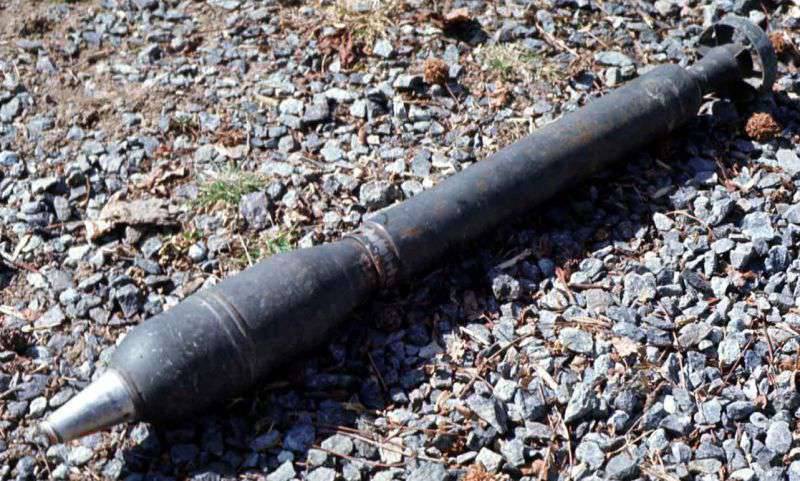
The thin-walled barrel of the LNG-82 grenade launcher consisted of breech and muzzle parts that were interconnected by a coupling. The barrel, in turn, was mounted on a machine with a wheel course and a folding shield. The main purpose of the shield was to protect the calculation from the impact of the powder gases of a jet engine. When fired, the glazed observation windows in the shield were automatically closed with metal safety shutters. On the trunk were attached shoulder rest and mechanical sight. The shot was made using the self-cocking trigger mechanism.
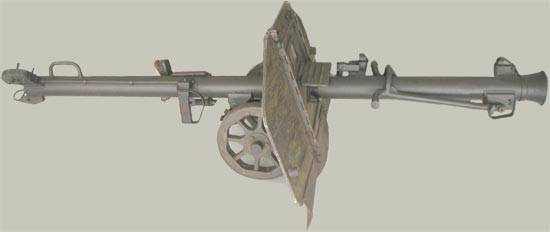
The calculation of the easel grenade launcher consisted of three people: the gunner, the loader and the carrier of ammunition. The range of the LNG-82 stand-alone grenade launcher was 200 meters, and the combat rate of fire was up to 6 shots / min. The mass of LNG-82 in a combat position is 32 kg, which was even less than that of the SG-43 machine gun on a wheel bench. The LNG-82 machine-gun grenade launcher was put into service in the 1950 year. For that time it was quite effective. weaponable to penetrate the frontal armor of most modern tanks.
Organizationally, the 82-mm grenade launchers were anti-tank means of a motorized rifle battalion. The baptism of the LNG-82 took place in Korea. With sufficient effectiveness against armored targets, it turned out that it was desirable to introduce fragmentation ammunition into ammunition. In this regard, the OG-82 frag grenade was developed. The firing range of the fragmentation grenade was 700 m. The introduction of fragmentation grenades made it possible to expand the combat capabilities of the grenade launcher. In addition to the fight against tanks, the opportunity has appeared to successfully solve the tasks of hitting fire weapons and enemy manpower.
Simultaneously with the 82-mm grenade launcher, its enlarged 122-mm version was designed. During the tests, the LNG-122 revealed that it needs to be improved, as it is dangerous for its calculation because of the powerful jet. The modified grenade launcher, designated SG-122, was successfully tested. Its combat rate of fire was 5 rds / min, and its mass was 45 kg. With the direct shot 200 m, the cumulative SG-122 grenade could penetrate 300 mm armor. Since the lighter and more compact LNG-82 fully met its requirements, SG-122 was not launched into mass production.
In the 60-70-s, as the Soviet Army replaced more advanced models, the LNG-82 grenade launchers were delivered to the allies of the USSR under the Warsaw Pact and to the third world countries. This mounted grenade launcher was actively used during combat operations in local conflicts. But at the moment it is hopelessly outdated and decommissioned.
Almost simultaneously with the LNG-82, deliveries of the RPG-2 anti-tank grenade launcher began to the troops. The grenade launcher, in many respects resembling the RPG-1, was created in the Design Bureau of the GSKB-30 of the Ministry of Agricultural Engineering under the direction of A.V. Smolyakova. Having a similar device, the RPG-2 significantly exceeded the RPG-1 in combat characteristics, first of all, in the range of target destruction. The direct shot range of the RPG-2 was doubled to 100 meters. The cumulative 82-mm overhead caliber PG-2 grenade weighing 1,85 kg after firing the bottom fuze could penetrate 200 mm armor, which allowed destroying the heavy tanks of that time. The grenade launcher weighed 4,5 kg and had a length - 1200 mm. Although black powder was used as a propellant charge, as was the case with the RPG-1, which was not accepted for service, by increasing the length of the launch tube and the caliber from 30 to 40 mm, it was possible to significantly increase the range of the aimed shot. The design of the grenade launcher was very simple. The barrel was made of 40-mm steel seamless pipe. In the middle of the barrel to protect against burns when fired and more comfortable use of weapons in low temperatures there were wooden lining. For aiming weapons used a mechanical sight, designed for a distance of 150 m. Shock-trigger mechanism of the hammer type with prying mechanism ensured the reliability and convenience of firing a shot.

To the cumulative PG-2 grenade with a threaded connection before the shot was attached to a cardboard sleeve, equipped with black gun powder. The stabilization of the grenade in flight occurred with six flexible steel feathers, folded around the tube and unfolding after taking off from the barrel.
Due to the good combat and service-operational data, as well as the low cost, the RPG-2 is widely used and used in many local conflicts. In addition to fighting armored vehicles, a grenade launcher during combat operations was often used to destroy firing points and light fortifications. RPG-2 was widely supplied to the allies of the USSR, and a number of countries received a license to produce it. Since at the end of 60-x - the beginning of 70-x the armor thickness of Western tanks increased markedly, in order to increase armor penetration in Poland and China, they developed their own cumulative grenades with better characteristics. The DPRK also adopted a grenade with a fragmentation shirt that could be effectively used against manpower.
RPG-2 was a very successful weapon, when it was created, technical solutions were laid, which later became the base when creating more advanced grenade launchers. Chinese copies of the RPG-2 are still in service in a number of Asian and African countries. At the same time, the grenade launcher was not without flaws. The use of black powder in the propellant charge, which had a low energy potential, when fired, led to the formation of a cloud of thick white smoke unmasking a grenade launcher position. In conditions of high humidity, the cardboard sleeve swelled, which made loading difficult, and the powder, dampened, became unsuitable for firing. Due to the low initial speed of the PG-2-85 grenade, m / s, it was very susceptible to wind drift on the trajectory. Only a well-trained grenade launcher could get into a tank with a side wind 8-10 m / s at a distance of 100 meters.
In the late forties, the designers of GSKB-47 (now NPO Basalt) created a new hand-held anti-tank grenade RKG-3. This ammunition was supposed to replace in the troops manual cumulative grenades RPG-43 and RPG-6. In addition to improving armor penetration, great importance was attached to the safety of circulation. With a weight of 1,07 kg and a length of 362 mm, a well-trained fighter could throw a grenade on the 20-22 m. The first modification of the grenade could penetrate 150 mm armor at a meeting angle of up to 30 ° to the normal, which allowed to confidently hit not only the hull roof, but also the frontal armor medium tanks.
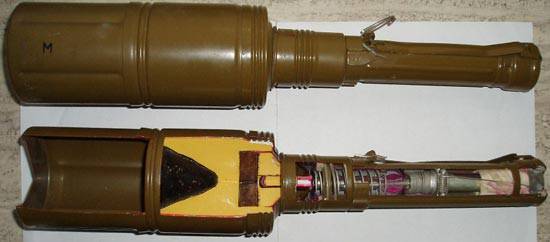
Compared to cumulative wartime grenades, the design of the RGK-3 was more thoughtful. In order to avoid accidents, the anti-tank grenade has four protections. When preparing a grenade for use, it was required to place a fuse in the handle, then screw it to the body. After removing the checks with the ring, the movable coupling and the strap were unlocked. The inertial mechanism of the movable coupling and several balls did not allow the impact mechanism to work before the fighter made a swing and threw a grenade to the target. After a vigorous swing and throw, this fuse initiated the detachment of the flap and bottom cover of the handle. After removing the cover from the handle threw a cloth stabilizer. Opened stabilizer oriented grenade head part in the direction of flight and moved from place a special spring-loaded rod held in place by balls and a spring. Another fuse was a shock spring. In flight, she held the inertial load and drummer in the rearmost position. The operation of the inertial impact mechanism and the undermining of the shaped charge could occur only when striking the hard surface of the grenade head. Although the grenade became more secure, it was allowed to use it only from cover.
In the middle of the 50-x, advanced modifications of the GSC-3E and GSC-3Е were adopted. The design of the ammunition has not changed, the improvements have affected only the cumulative charge and production technology. New grenades received a shaped charge with a copper lining of a cumulative funnel. In addition, the shape of the funnel has changed. Thanks to the modifications, the armor penetration capability of the PKG-3 grenade was 170 mm, and the PKG-3Е was 220 mm of homogeneous armor.
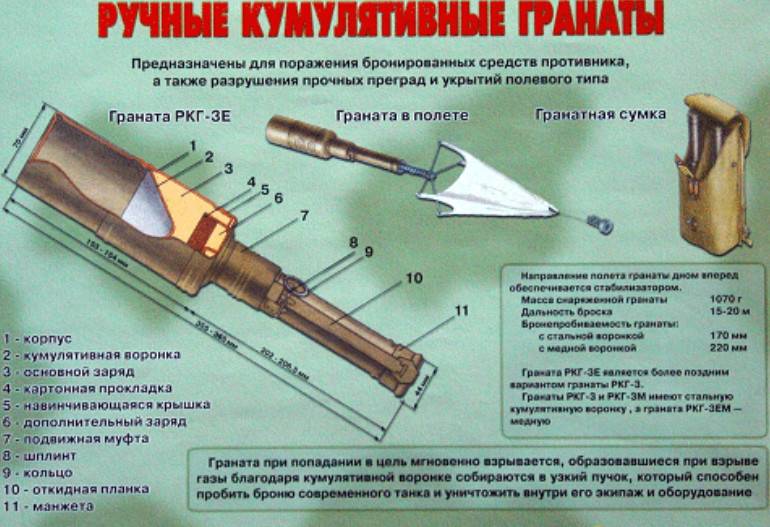
The anti-tank grenades of the RGK-3 family were the standard weapons of the Soviet infantry prior to the adoption of the RPU-18 “Mukha” disposable rocket grenades. In the warehouses of the mobilization reserve of the Defense Ministry of the Russian Federation, these grenades are still available. In Soviet times, RGK-3 was widely shipped abroad and actively used in regional wars. During the invasion of Iraq, the US armed forces lost several tanks and armored personnel carriers from the impact of these seemingly hopelessly outdated ammunition.
In the second half of the 50-x in several design offices was the creation of hand-held anti-tank grenade launchers. The anti-tank weapon of the new generation was to at least double the RPG-2 in firing range and ensure penetration of the frontal armor of all existing tanks, as well as have armor penetration reserve, which made it possible to fight promising armored vehicles. In addition, it was separately discussed to increase the reliability and moisture resistance of the jet fuel charge.
In 1957, the tests of the RPG-4, created in GSKB-47, began. In fact, the RPG-4 was an RPG-2 grenade launcher enlarged in size. Unlike the RPG-2, the RPG-4 had an enlarged charging chamber and an 45 caliber mm. With the simultaneous use of fuel based on nitroglycerin powder contributed to the increase in the initial speed of the grenade and sighting range of fire. At the breech breech in order to disperse the jet stream appeared socket.
The mass of the grenade launcher was 4,7 kg, length -1200 mm. Direct shot range - 143 m. Sighting range - 300 m. Anti-tank cumulative PG-2 grenade of 83-mm caliber and 1,9 kg mass, normal could penetrate 220 mm homogeneous armor. The grenade was stabilized on the trajectory by six lamellar blades, which are folded before the shot.
The RPG-4 anti-tank grenade launcher successfully passed field testing, and by its characteristics it was quite comfortable for the military. In 1961, an experimental batch of grenade launchers was launched for military trials. But as you know, the best is the enemy of the good. Almost simultaneously with the RPG-4, the customer was presented with a more advanced RPG-7, which later became a weapon-classics and grenade launcher "of all times and peoples."
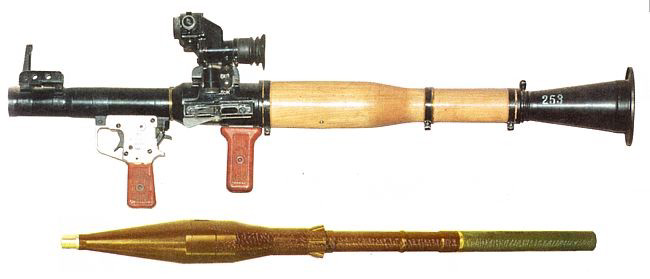
During the creation of the RPG-7, the designers of GSKB-47 took into account the experience of the combat use of domestic and foreign anti-tank grenade launchers. Specialists from the Kovrov Mechanical Plant and the Tula TsKIB SOO also took part in the development. The cumulative grenade and jet engine were developed under the direction of V.K. Firulina.
A unique feature of the PG-7B anti-grenade was the use of a piezoelectric fuse. To stabilize the grenades in flight, four drop-down blades are used. In order to increase the accuracy of shooting and compensate for errors in the manufacture of grenades due to the tilt of the stabilizer blades, rotation is transmitted at a speed of several tens of revolutions per second. The X-NUMX-mm anti-tank PG-85 anti-tank grenade with a mass shot of 7 kg could penetrate 2,2 mm armor. The initial speed of the grenade is about 260 m / s, at the end of the active section it increases to 120 m / s. Due to the relatively high initial speed and the presence of the active part of the jet engine, compared with PG-300, it was possible to significantly increase the accuracy and firing range. When the direct shot 2 m, sighting range - about 330 m.
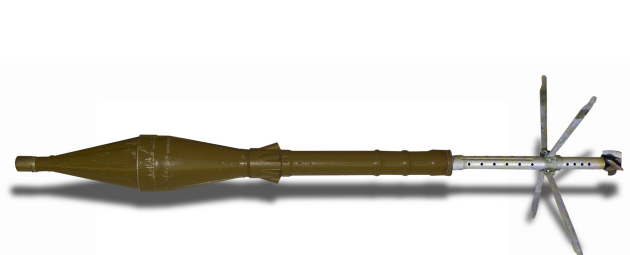
The design of the RPG-7 is based on the successful technical solutions of the RPG-2 with a reusable starting device and a shot with the above-caliber warhead. In the middle part of the trunk RPG-7 there is a special charging chamber, which allows you to more efficiently use the energy of the propellant charge. To disperse the jet stream when fired, a socket is used in the breech breech. The RPG-7 hand-held grenade launcher, in addition to the mechanical sight, was equipped with an 2,7 optical lens with the PGO-7 multiple sight. The telescopic sight had a scale of the rangefinder grid and side corrections, which increases the accuracy of shooting and allows you to effectively introduce corrections taking into account the range and speed of the target. After adopting the new more efficient cumulative grenades, they began to mount sights on the grenade launchers (PGO-7В, PGO-7В-2, PGO-7В-3, etc.) in which ballistics of different types of grenades was taken into account. In addition to the standard optical sight, it is possible to install night sights. The grenade launchers with the “H” index have a mechanism that disables the sight at the moment of the shot, in order to prevent its exposure to flash when fired.
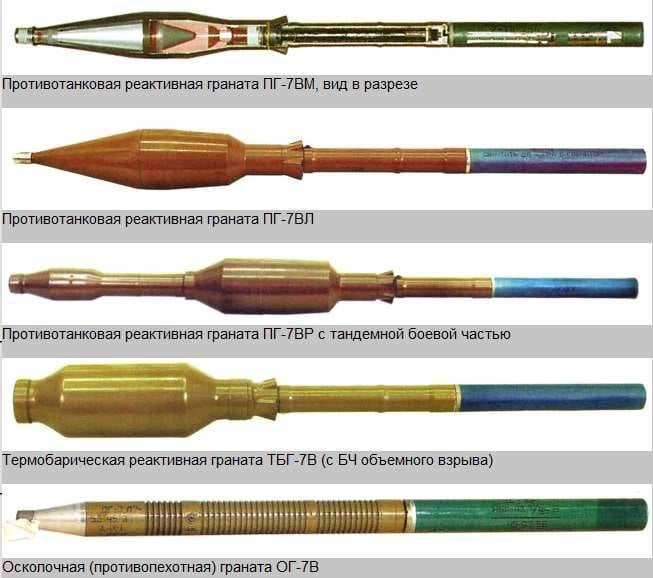
Depending on the modification and destination, RPG-7 ammunition has a 40 caliber -105 mm with armor penetration to 700 mm for dynamic protection, and a mass from 2 to 4,5 kg. In 80-90, the Basalt specialists for the RPG-7 created fragmentation and thermobaric grenades, which greatly expanded the flexibility of use and combat effectiveness.
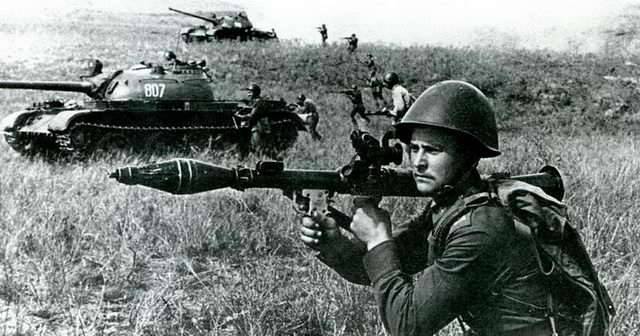
In the Ground Forces of the Soviet Army there was a grenade launcher in every motorized rifle unit. RPG-7 for decades was the main type of anti-tank grenade launcher in the Soviet Army. With a weight depending on the type of 8,5-10,8 kg grenades and the length of the 950 mm grenade launcher could hit all the tanks of a potential enemy. By order of the airborne troops, an RPG-7D was created, the design of which allowed the grenade launcher to be dismantled in preparation for the landing. The RPG-7 grenade launcher, put into service in the 1961 year, thanks to the creation for it of increased efficiency shots is still able to fight with modern armored vehicles. In terms of weight and size and combat characteristics, the “cost-effectiveness” criterion, the RPG-7 with modern types of jet grenades still has no competitors.
For the first time, RPG-7 was used in combat in the middle of the 60-s in Vietnam. Vietnamese guerrillas, who previously had Soviet and Chinese-made RPG-2, quickly assessed the capabilities of the new grenade launcher. With the help of the RPG-7, they fought not only with American armored vehicles, but also delivered effective strikes against transport convoys and fortified positions. In the jungle of Southeast Asia, it turned out that an anti-tank grenade launcher could be an effective means of fighting low-flying helicopters. Repeatedly, there were cases when the pilots of the American attack aircraft and fighter-bombers stopped the attack or carried out an unforward drop of bombs, taking a shot from a grenade launcher for an anti-aircraft missile of MANPADS. RPG-7 also performed well in Arab-Israeli conflicts.
According to the experience of the “Doomsday” war, the “anti-tank special forces” were formed in the Syrian army, whose fighters were armed with RPG-7 grenade launchers and portable anti-tank systems. In 1982, the Syrian "anti-tank special forces" managed to inflict significant losses on Israeli tank crews during the fighting in Lebanon. With a massive targeted fire from grenade launchers, the Blazer “reactive armor” did not always help. An indirect recognition of the high combat properties of the RPG-7 was the fact that captured Soviet grenade launchers were in service with the Israel Defense Forces. RPG-7 actively used in armed conflicts in the post-Soviet space, becoming a kind of "Kalashnikov" among the grenade launchers. The main losses of the anti-terrorist coalition armored vehicles in Afghanistan and Iraq are connected with hits of PG-7 grenades. Although the Russian Army has more modern anti-tank grenade launchers, the latest-generation RPG-7 are the most popular among the re-usable grenade launchers. Being one of the most common and effective models of light anti-tank weapons, RPG-7 is used in armies of more than 50 states. Taking into account foreign copies, the number of RPG-7 produced is approximately 2 million copies.
Simultaneously with the work on the creation of a light anti-tank grenade launcher suitable for carrying and use by one shooter, the creation of an easel grenade launcher was carried out, which in terms of range and firing accuracy had to repeatedly surpass the LNG-82. The Ground Forces Command wanted to significantly increase the effective range of anti-tank weapons of motorized rifle units.
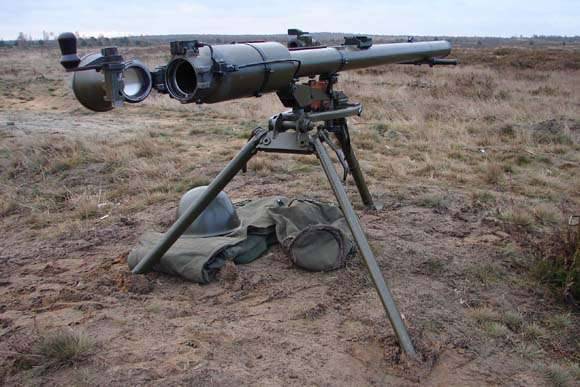
In 1963, the 73-mm heavy machine gun SPN-9 "Spear" was adopted. Just like the RPG-7, it was created in GSKB-47 (now FSUE “Basalt”). For firing from a grenade launcher, an active-reactive grenade PG-9 was used, which accelerated after the engine had run to 700 m / s. Due to a fairly high flight speed, comparable to the speed of an artillery shell, PG-9 compared with PG-7 had a much better accuracy of impact and a much longer range.

In the tail of the PG-9 shot is a jet engine that starts after the departure of a grenade from the barrel. The starting charge consists of a sample of nitroglycerin powder in a cloth cap. The ignition of the starting charge is carried out by a special igniter with electric igniter. After the grenade leaves the barrel, a six-pointed stabilizer opens. In the tail part of the PG-9 there are tracers with which you can observe the flight on the trajectory. Cumulative grenade, depending on the modification, is capable of penetrating 300-400 mm of homogeneous armor. Like PG-7, PG-9 grenade is equipped with a highly sensitive piezoelectric fuse.
Structurally, the LNG-9 is a lightweight breech-loading recoilless weapon mounted on a tripod machine. With a barrel length of 670 mm, the effective firing range of the tanks is 700 meters, which is more than twice the effective range of the RPG-7. Rate of fire to 6 rds / min.
At the beginning of the 70-x, a modernized version of the LNG-9M began to be delivered to the troops. The composition of the ammunition included shots with increased armor penetration and increased to 900 meters direct shot range. The fragmented grenade OG-9 was adopted to the modernized grenade launcher. It does not have a jet engine, but only a starting powder charge. The maximum firing range of the FG-9 - 4500 meters. The new version of the grenade launcher was equipped with the PGOK-9 sighting device, which consists of two separate sights: one for firing cumulative direct grenades, the second for the use of a fragmentation grenade.
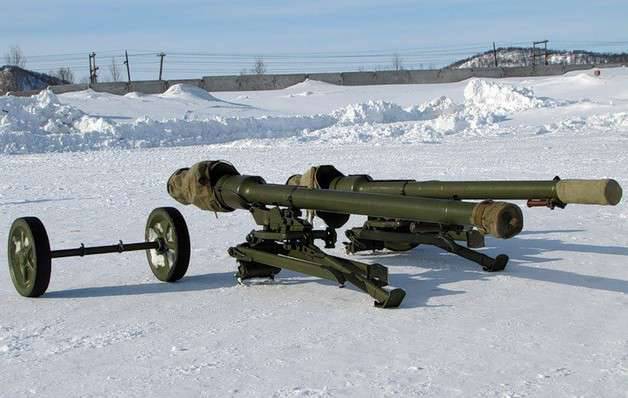
The mass of the grenade launcher in a combat position is 48 kg, length - 1055 mm. On the battlefield, a grenade launcher can be transported over short distances based on four people. For transportation over long distances, the grenade disassembled disassembled into separate units. Especially for the airborne troops created a modification with a wheel course. The overall dimensions of the LNG-9 allow it to be mounted on various vehicles and light armored vehicles. This quality turned out to be especially in demand in the Airborne Forces and in mobile reconnaissance and shock units. During regional wars, grenade launchers on mobile chassis, as a rule, were used not to combat armored vehicles, but to destroy manpower with fragmentation grenades and to destroy lightweight shelters.
The LNG-9, which replaced the LNG-82, being a rather heavy weapon, did not deserve such fame as the RPG-7. However, this mounted grenade launcher was also widespread. In addition to the USSR, licensed production of LNG-9 grenade launchers and ammunition was carried out in a number of countries of the former Eastern Bloc. This weapon has proved itself well in many local wars. The relatively low weight and good accuracy make it possible to effectively use LNG-9 in street fights. Soviet stalk grenade launchers can be seen in reports shot in South-Eastern Ukraine and Syria. Earlier this year, Russian media reported that the upgraded LNG-9, equipped with new night sights, are being used by Russian special units as fire support weapons.
In 1970, a rather unique RPG-16 “Strike” anti-tank grenade launcher, created in TKB under the guidance of I.Ye. Rogozin. The uniqueness of this sample, created specifically for the Airborne Forces, was that it used the caliber 58,3 - mm cumulative PG-16 grenade, and the grenade launcher itself could be disassembled into two parts.
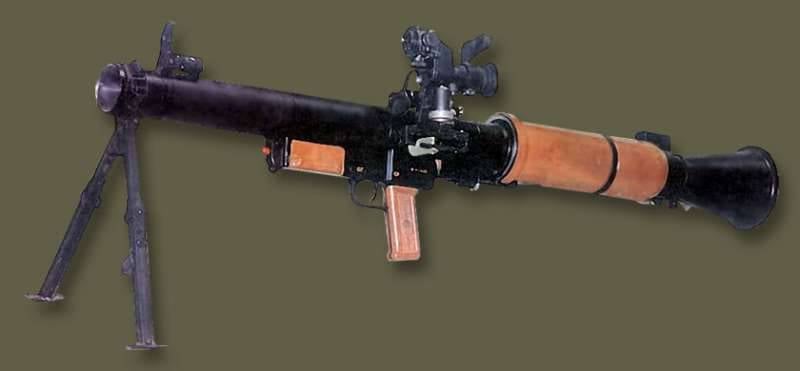
Due to the high initial and marching flight speeds, the direct shot range and accuracy have increased significantly. The circular deviation of PG-16 at a distance of 300 m was about 1,5 times less than that of PG-7В. The direct shot range was 520 m. At the same time, despite the relatively small caliber - 58,3-mm, PG-16 grenade, due to the use of a more powerful explosive in combination with the copper casing of the cumulative funnel and precise selection of the focal length, 300 mm armor penetration was available. At the same time, compared with the RPG-7, a specially designed landing grenade launcher was larger and heavier. Its mass was - 10,3 kg, and the length of the assembled - 1104 mm.
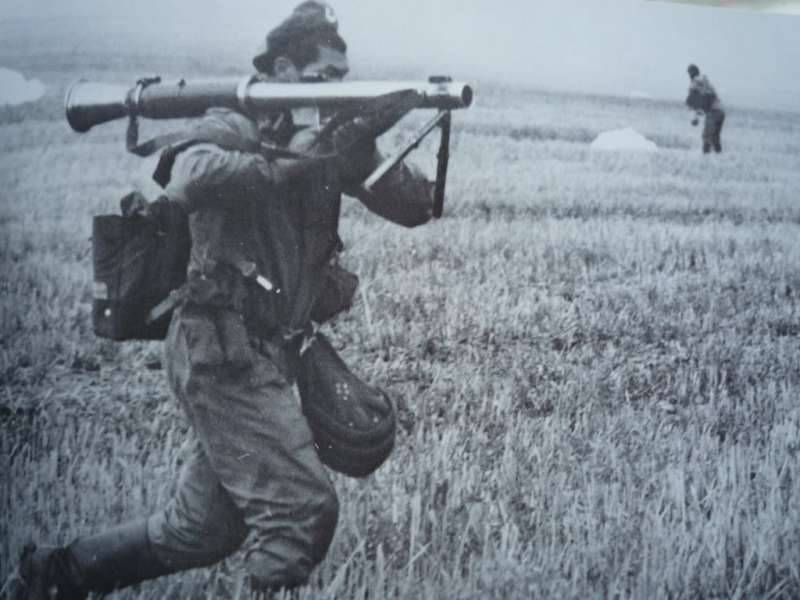
Surpassing the RPG-7 by the effective fire range almost doubled, the RPG-16 fully met the requirements before the advent of new-generation tanks with multi-layered frontal armor. However, despite the high accuracy and decent firing range, the RPG-16 did not have the modernization potential. If the RPG-7 had the possibility of increasing the dimensions of the above-caliber cumulative grenade, then in the case of PG-16 there was no such possibility. As a result, after the adoption of the Abrams, Challengers and Leopards-2 into NATO, the RPG-16 was rapidly outdated and the landing force fully switched to the RPG-XNUMHD with new grenades of increased power. Information about the use of RPG-7 against armored vehicles could not be found, but the landing caliber grenade launcher with the "loaded" barrel proved to be a good idea in Afghanistan. Since the accuracy and range of fire were comparable to the distance of the automatic rifle, the rocket launchers, armed with RPG-16, effectively suppressed the firing points of the rebels. For this reason, even despite the greater weight and size, "sniper grenade launchers" were popular among the "limited contingent" soldiers. Currently, RPG-16 grenade launchers are available at storage bases and are not being used in combat units of the Russian armed forces.
To be continued ...
Based on:
http://weaponland.ru/load/granatomet_spg_82_sg_82/61-1-0-487
http://russianguns.ru
http://ryadovoy.ru/militarizm/antiarmored/grenade_RPG.htm
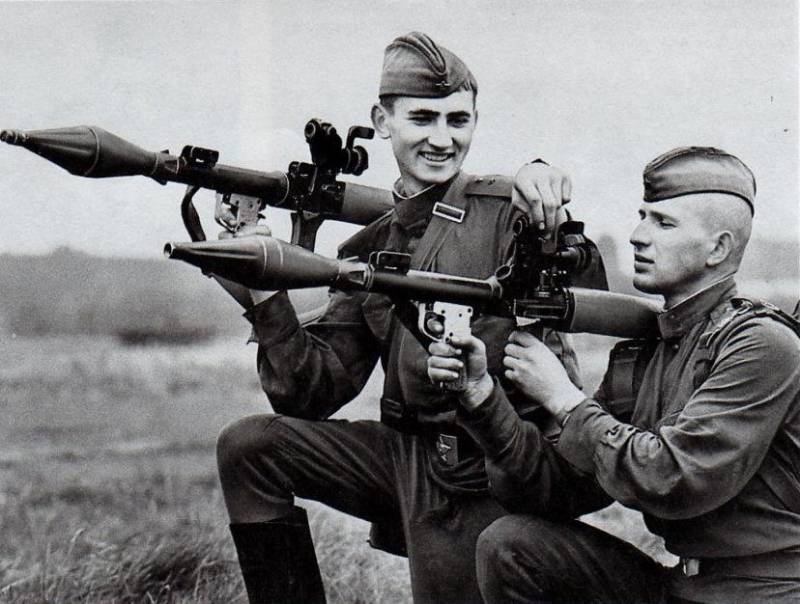
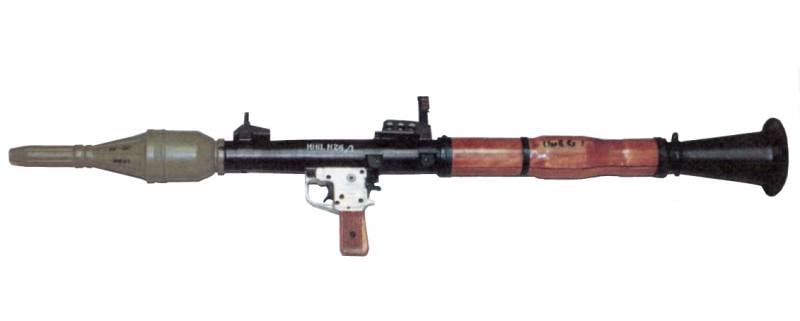
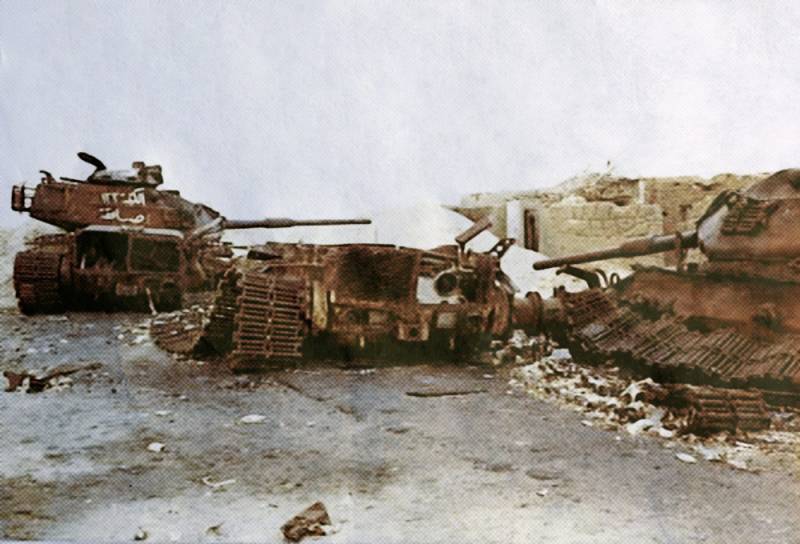
Information